1953
| | This section needs expansion. You can help by adding to it. (January 2024) |
- National Comics Publications v. Fawcett Publications is settled outside of court. Fawcett Comics stops making comics and pays DC Comics a lump sum of $400,000
| Timeline of DC Comics |
|---|
| 1930s, 1940s, 1950s |
The 1950s was the birth of many relevant characters and marked a resolution between DC Comics and Fawcett comics. This led to DC Comics adopting multiple Fawcett Comics characters, like Hopalong Cassidy.
Some relevant characters that were created during this decade are Deadshot, Lana Lang, Killer Moth, Dr. Thirteen, Rex The Wonder Dog, Firefly, Martian Manhunter, Batwoman, Iris Allen, Captain Cold, Brainiac, Supergirl, Calendar Man, Phantom Stranger, and Bizarro.
This decade also included the first uses of certain ideas or concepts, like the Red Hood backstory for the Joker and the Fortress of Solitude, alongside being the first decade in which teamwork between Superman and Batman occurred.
| | This section needs expansion. You can help by adding to it. (January 2024) |
| | This section needs expansion. You can help by adding to it. (January 2024) |
| | This section needs expansion. You can help by adding to it. (January 2024) |
| | This section needs expansion. You can help by adding to it. (January 2024) |
| | This section needs expansion. You can help by adding to it. (January 2024) |
| | This section needs expansion. You can help by adding to it. (January 2024) |
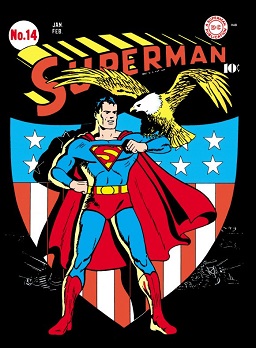
The Golden Age of Comic Books describes an era in the history of American comic books from 1938 to 1956. During this time, modern comic books were first published and rapidly increased in popularity. The superhero archetype was created and many well-known characters were introduced, including Superman, Batman, Robin, Captain Marvel, Captain America, and Wonder Woman.

The Phantom Zone is a prison-like parallel dimension appearing in American comic books published by DC Comics. It is mainly associated with stories featuring Superman. It first appeared in Adventure Comics #283, and was created by Robert Bernstein and George Papp. It was frequently used in the Superman comics before the continuity was rebooted in the 1980s, after Crisis on Infinite Earths, and has appeared occasionally since.
Krypto, also known as Krypto the Superdog, is a superhero dog appearing in American comic books published by DC Comics, commonly in association with the character Superman. In most continuities, Krypto is Superman's pet dog, usually depicted as a white dog of a generic pedigree often resembling a Labrador Retriever, a plain white Dalmatian, or a White Shepherd.
John Broome, who additionally used the pseudonyms John Osgood and Edgar Ray Meritt, was an American comic book writer for DC Comics. Along with Gil Kane, he co-created the supervillain Sinestro.
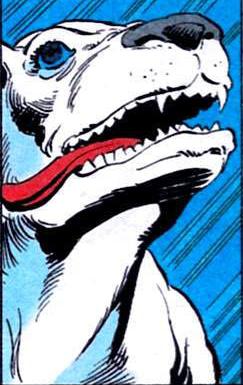
Rex the Wonder Dog is a fictional superhero dog in the DC Comics universe. Created in 1952 by Robert Kanigher of Wonder Woman fame and artist Alex Toth, Rex has sometimes been compared to Superman's dog Krypto, who was created three years later. While the two canine crime fighters do share some similarities, they are decidedly different.
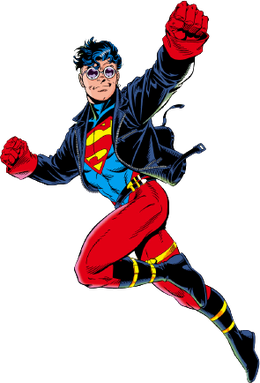
Superboy is a superhero appearing in American comic books published by DC Comics. A modern variation on the original Superboy, the character first appeared as Superboy in The Adventures of Superman #500, and was created by writer Karl Kesel and artist Tom Grummett.
Notable events of 1942 in comics.
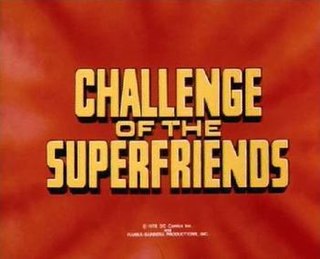
Challenge of the Superfriends is an American animated television series about a team of superheroes which ran from September 9 to December 23, 1978, on ABC. The complete series was produced by Hanna-Barbera Productions and is based on the Justice League and associated comic book characters published by DC Comics and created by Julius Schwartz, Gardner Fox and Mike Sekowsky. It was the third series of Super Friends cartoons, following the original Super Friends in 1973 and The All-New Super Friends Hour in 1977.

Superboy is a superhero that appears in American comic books published by DC Comics. The character was created by Jerry Siegel and Don Cameron and is based on the character of Superman that Siegel co-created with Joe Shuster. Superboy first appeared in the comic book More Fun Comics #101 in 1945.
DC Universe: Justice League Unlimited Fan Collection is an action figure line based on the highly popular Justice League and Justice League Unlimited animated series. Though it was based on the show(s), the line has continued well beyond it, and has been re-branded in 2008, as a Target exclusive. Mattel announced in February 2011 that the line would come to an end later in the year with the final figures being released on the Mattel website including the final two three-packs, a seven-pack as well as the three exclusive Con three-packs being made available to the public.
Notable events of 1943 in comics.
The DC Comics Super Hero Collection was a fortnightly magazine collection, by Eaglemoss Publications, and DC Comics, launched on the 15 March 2008, in the United Kingdom. The series was inspired by the success of The Classic Marvel Figurine Collection, also published by Eaglemoss. Each issue featured a hand painted, lead figure of a character from DC comic books, as well as an informational magazine, about the character. The collection consisted of two regular issues a month, with a special issue released every two months, to accommodate the larger characters in the DC Universe. The series also spawned a sub-series called "The Blackest Night/Brightest Day" collection, featuring characters from the various lantern corps from the DC Universe.
Super Juniors are a group of fictional DC Comics characters based on members of the Justice League of America, designed as baby versions in order to appeal to younger audiences and introduce them to the publisher's most popular properties. At Kenner's request, first appeared in José Luis García-López's 1982 DC Comics Style Guide and had their first and only adventure in Super Jrs. Holiday Special: The Best of DC Blue Ribbon Digest #58 in a story written by Tom DeFalco and drawn by Vince Squeglia. There was a considerable amount of merchandise based on them.
Francis Edward Herron was an American comic book writer and editor active in the 1940s–1960s, mainly for DC Comics. He is credited with co-creating Captain Marvel Jr. and the Red Skull, as well as such characters as Cave Carson, Nighthawk, and Mr. Scarlet and Pinky the Whiz Kid. Herron spent the bulk of his time in the comics industry writing for such characters as Green Arrow, Superman, and the Western character Tomahawk.
Robot Chicken DC Comics Special 2: Villains in Paradise is an episode of the television comedy series Robot Chicken and it was aired as a half-hour special during Cartoon Network's Adult Swim on April 6, 2014. It serves as the sequel to the Robot Chicken DC Comics Special that focuses more on the Legion of Doom and is followed by Robot Chicken DC Comics Special III: Magical Friendship.
Donald Clough Cameron was an American writer of detective novels and comic books. He is credited with creating several supporting characters and villains in DC Comics' line of Batman comic books.
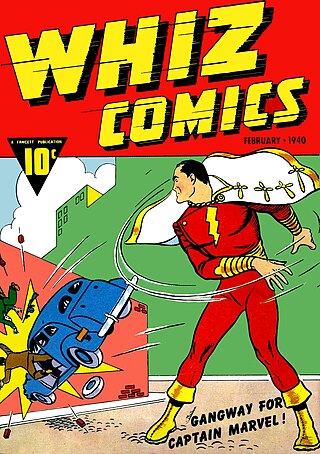
The 1940s were an essential time for DC Comics. Both National Comics Publications and All-American Publications would introduce many new featured superheroes in American comic books in superhero comics anthology tales like More Fun Comics, Adventure Comics, Detective Comics, Action Comics, All-American Comics, Superman, Flash Comics, Batman, All Star Comics, World's Finest Comics, All-Flash, Star Spangled Comics, Green Lantern, Leading Comics, Sensation Comics, Wonder Woman, Comic Cavalcade and Superboy that would be a staple for the comic book company. Examples of the superheroes include the Flash, Hawkman and Hawkgirl, Johnny Thunder and Thunderbolt, Spectre, Hourman, Robin, Doctor Fate, Congo Bill, Green Lantern, Atom, Manhunter, Doctor Mid-Nite, Sargon the Sorcerer, Starman, Johnny Quick, the Shining Knight, the Star-Spangled Kid and Stripesy, Tarantula, Vigilante, Green Arrow and Speedy, Aquaman, Wonder Woman, Sandy, the Golden Boy, Mister Terrific, Wildcat, Air Wave, Guardian, Robotman, TNT and Dan the Dyna-Mite, Liberty Belle, Superboy and Black Canary. These characters would later crossover in superhero team titles in the 1940s such as the Justice Society of America and the Seven Soldiers of Victory helping pave a way to a shared universe of the publication company. Other used featured characters outside of superheroes included kid titular heroes like the Newsboy Legion and the Boy Commandos. Later Western heroes would be used such as Johnny Thunder, Nighthawk and Pow Wow Smith.

Suicide Squad: Kill the Justice League is a 2024 action-adventure shooter game developed by Rocksteady Studios and published by Warner Bros. Games. Based on the DC Comics team Suicide Squad, it is a spin-off of the Batman: Arkham series, and a follow-up to Batman: Arkham Knight (2015). Set five years after the events of Arkham Knight, the game's storyline follows four supervillains—Captain Boomerang, Deadshot, Harley Quinn, and King Shark—who are assembled by Amanda Waller and sent to Metropolis to stop the alien invader Brainiac and kill the members of the Justice League who fell under his influence.
[Deadshot] was originally created by Bob Kane, David Vern Reed and Lew Sayre Schwartz in 1950 as a prime villain for Batman.
DC picked up on renewed public interest in science fiction by launching its first comic in the genre, the anthology series, Strange Adventures. The series kicked off its 244-issue run with an adaptation of the first color science fiction movie, Destination Moon (released that same month), written by Gardner Fox and drawn by Curt Swan.
{{cite book}}: |first2= has generic name (help)CS1 maint: multiple names: authors list (link)